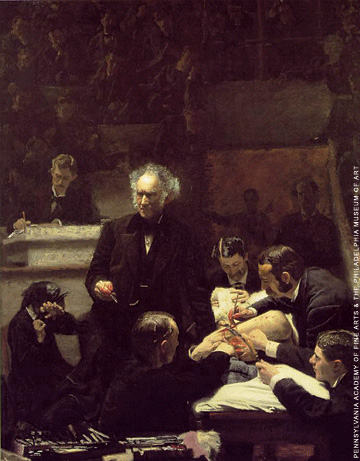
For David Fox, director of new-student orientation and the Penn Reading Project (PRP), this year’s choice of Thomas Eakins’ The Gross Clinic represented something of a “light bulb moment.”
“We knew going into this that our theme this year would be devoted to the arts, which opened the door to the possibility of another kind of text—art, music, film,” says Fox, whose titles also include associate director of College Houses and Academic Services and lecturer in theatre arts. So when interim provost Vince Price, professor of communication and a member of the PRP committee, refined the theme to “Art and the City,” with an emphasis on Philadelphia, the light bulb flashed.
Eakins’ 1875 masterpiece represents the first departure from a text-only book in the 19-year history of the PRP, and Fox acknowledges that there are still some details to be worked out in order to get the incoming freshmen—and the faculty seminar leaders—ready for their summer “reading.”
“There will be a website with a number of special features, including a ‘Guide to Seeing’ that the art-history department is putting together,” says Fox. “There will be high-quality images of Gross Clinic on the website, which will also include podcasts helping students to explore the painting visually, and underscoring some of the things to look for. We’ll furnish posters to the individual College Houses, and have some copies of the painting to give to students who have limited Web access. There will also be one or two accompanying readings, ranging from materials that give historical context to the painting, to editorials that give an account of the campaign to keep the painting in Philly.”
That last part refers to the spirited—and successful—effort a couple of years ago to buy the painting from Thomas Jefferson University for $68 million and keep it in the city. It is now jointly owned by the Philadelphia Museum of Art (PMA), where it is undergoing conservation, and the Pennsylvania Academy of Fine Arts.
The night before the project discussions begin for the incoming freshmen, there will be a “gala event at PMA,” says Fox. “Normally, this would of course be the time they would see Gross Clinic.” As it happens, the painting will probably still be stuck in the conservation department, but the museum will have other Eakins paintings on display, including Portrait of Professor Benjamin H. Rand and the very Penn-centric Agnew Clinic [“Gazetteer,” March|April 2007]. Docents will be on hand to discuss them. “When Gross Clinic is back on display in early spring,” notes Fox, “we’ll have another event at the museum.”
For Penn and for Philadelphia, The Gross Clinic—with its bloody, almost biblical sense of drama, its fusion of modern medicine and art—resonates on many levels, both artistic and historical.
“The fact that Philadelphia—and Penn—were at the center of American medical innovation during the period when Eakins painted Gross and other works is significant,” says Fox. As a result, the PRP’s press release notes, “We expect particular participation in the medical and nursing schools, the history and sociology of science, biology, and other sciences.”
So far the choice of The Gross Clinic has sparked “lots of enthusiasm from many different quarters,” says Fox. “I’ve also heard from some faculty who are nervous—they’ve never talked about a painting before. I always point out that, like all PRP texts, we see this as a multidisciplinary inquiry—and one where each discussion leader can find her own areas to emphasize.”
—S.H.




